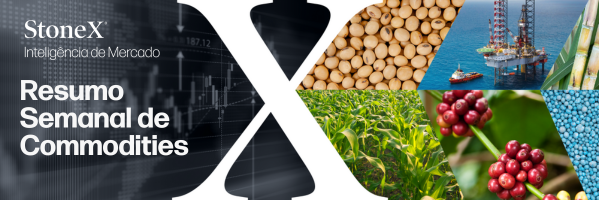
Translated from the original in Portuguese by Rodolfo Abachi
StoneX’s Market Intelligence team has created a series of reports on green hydrogen, a new and promising market for decarbonizing the global energy matrix.
Hydrogen is the most abundant element in the universe and has numerous applications, such as fuel and feedstock in industries.
The e-book provides a comprehensive overview of hydrogen, distinguishing between its various forms (gray, blue, and green).
This article talks about how it can be applied in various sectors, including but not limited to industry, transportation, and power generation.
In addition, we will explore transportation, storage, international trade, and Brazil’s potential in this growing field.
Topics covered
Hydrogen is the most abundant chemical element in the entire universe. In its natural state and under normal conditions, hydrogen (H2) is a colorless gas. When combusted, it only produces water and heat. Its use is widespread worldwide, especially as a feedstock for methanol and ammonia production, widely used in the fertilizer industry.
Hydrogen can store high energy levels and has a low molecular weight, with its use as a fuel being highly advantageous. According to IRENA’s scenario, its application has the potential to contribute 10% of the mitigation needed to achieve the goal set in the Paris Agreement to limit global warming to 1.5ºC by 2050.
International hydrogen production in its pure form stands at about 90 million tonnes annually, with an additional 45 million tonnes per year of mixed gases. The current productive capacity is equivalent to 3% of the final energy consumption in the world, and by 2050, this proportion may reach 12% (IRENA). The H2 production can occur from various sources and feedstocks and by numerous processes.
The terminology made by colors facilitates the differentiation of the various types of hydrogen; among them, the best known are gray, blue and green – also counting on more complex types of H2, such as turquoise and yellow. The benefits surrounding the use of green hydrogen – in addition to the storage and transport capacity of the energy generated – lie in the use of sustainable sources for electricity generation, which ultimately reduces greenhouse gas emissions.
Green hydrogen production in Brazil is still very embryonic. Only the White Martins plant, installed in Pernambuco, is already operating in the sector, and this unit’s production, at least for now, is quite limited at 156 tonnes/year.
Where is green hydrogen intended?
Hydrogen has several applications in different industries. Currently, the largest share of the demand for the gas is in the use in oil refining and ammonia and methanol production. In addition to these already consolidated uses, other destinations, such as energy storage, are considered promising for hydrogen.
One of the challenges for expanding the use of current renewable energy technologies is the intermittency in the energy supply due to the inconsistency of natural conditions – solar energy can’t be produced at night, and obtaining wind energy depends on the occurrence of winds, for example.
Thus, hydrogen, especially green, could circumvent this limitation, storing excess energy produced at times of favorable conditions. Suppose today most of the hydrogen is used by industry and in oil refining. In that case, IEA projections show that its demand for the electric power sector should strengthen in the coming years, reaching 72.9 million tonnes in 2070. Another use considered promising for green hydrogen is as a fuel.
It can be used to fuel cars, mining vehicles, trains, aircraft, trucks, buses and ships, being a sustainable alternative for mobility. In summary, green hydrogen has applications in various sectors, such as the production/storage of electricity, which can be used to supply homes, producing methanol, widely exploited by industries, and as fuel for vehicles of various sizes.
However, more than its applications per se, green hydrogen also stands out for decarbonizing the sectors in which it is used.
Don’t miss the opportunity to learn about the Green Hydrogen market! Stay on top of the trends and opportunities that this new industry offers.
Download the PDF report and deepen your knowledge about the promising green hydrogen market.
Access now!
Este artigo é um exemplo dos conteúdos disponíveis para assinantes no Portal de Relatórios.
A cobertura mais completa do Brasil em Inteligência de Mercado para commodities + plataforma exclusiva!
A Inteligência de Mercado da StoneX oferece assinaturas de relatórios periódicos para acompanhamento dos mercados de commodities agrícolas e energéticas no Brasil e no mundo.
CNPJ: 07.335.928/0001-76 © 2024 STONEX CONSULTORIA EM FUTUROS E COMMODITIES LTDA. | StoneX Group Inc. Todos os direitos reservados. A negociação de commodities e derivativos de balcão (mercado futuro, opções, swaps) não é adequada para todos os investidores e envolve risco substancial de perdas, e você deve compreender completamente esses riscos, antes de negociar. As informações contidas neste site não constituem recomendação de estratégias de negociação, produtos ou serviços de negociação prestados pela StoneX e/ou oferta de compra ou de venda de quaisquer derivativos; a decisão pelo tipo de investimento e/ou estratégias a adotar são de responsabilidade do cliente. O grupo de empresas StoneX somente negocia com clientes que satisfaçam os critérios de elegibilidade pertinentes à legislação aplicável à cada empresa específica dentro do grupo. Resultados financeiros passados não são indicativos de desempenho futuro e não levam em conta objetivos particulares de investimento, condições financeiras, ou necessidades específicas de qualquer indivíduo. As informações e/ou fatos contidos neste site foram obtidas de fontes que acreditamos ser de confiança, mas não há garantias quanto à sua exatidão ou integridade. Estes materiais representam as opiniões, os pontos de vista e as projeções do autor, salvo se indicado o contrário, e não necessariamente refletem os pontos de vista e estratégias de negociação empregadas pela StoneX. Ao utilizar este site você concorda com nossos Termos de Uso, Aviso Legal e Política de Privacidade.
